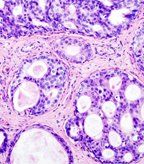Moving Toward Individualized Treatment for DCIS
How best to manage patients who present with ductal carcinoma in situ (DCIS), a noninvasive and early form of breast cancer, remains unclear. Treatment options range from minimal, breast-conserving surgical intervention and no follow-up treatment, to surgical intervention followed by additional treatment.
How best to manage patients who present with ductal carcinoma in situ (DCIS), a noninvasive and early form of breast cancer, remains unclear. Treatment options range from minimal, breast-conserving surgical intervention and no follow-up treatment, to surgical intervention followed by additional treatment.

Histopathologic image of DCIS; KGH, Wikimedia Commons
As a result of the prevalence of mammography, DCIS has been more frequently diagnosed in recent years. However, its management remains both controversial and uncertain. At the 30th Annual Miami Breast Cancer Conference, held March 7–10 in Miami Beach, Florida, Lawrence Solin, MD, chairman of radiation oncology at the Albert Einstein Medical Center and emeritus professor of radiation oncology at the Perelman School of Medicine at the University of Pennsylvania in Philadelphia, discussed ways to select individualized treatment for patients with DCIS.
“Management of DCIS is still somewhat controversial,” said Solin. Local treatment options include a lumpectomy alone or lumpectomy followed by radiation therapy. Rarely is a full mastectomy necessary for these patients. The systemic option following surgical removal of the breast mass is tamoxifen for women with hormone-positive DCIS, but other types of therapies are also being explored.
“These are mainly asymptomatic patients who have been diagnosed as a result of a routine mammography screening,” said Solin. “This context is important for treatment decision-making.”
While clinical and pathological factors, including patient age, surgical margins, tumor size, and tumor grade, have helped clinicians make rational treatment decisions for individual patients, this approach remains imperfect. “The problem we face in the clinic is that there are not very good scientific ways to make individualized treatment decisions together with our patients,” said Solin. Randomized clinical trials of radiotherapy or tamoxifen treatment for patients with DCIS, on average, show a decrease in risk of developing invasive breast cancer. The problem is that this still results in overtreatment, as some patients have very low risk of recurrence, but the standard clinical and pathological parameters have not been able to consistently identify these patients.
Solin has helped develop a molecular DCIS score as a tool to predict recurrence risk for DCIS patients. The results of a validation study using the risk assessment tool were presented at the San Antonio Breast Cancer Symposium in 2011. The DCIS score assesses the underlying biology of DCIS and was prospectively validated in the ECOG E5194 trial.
“The molecular score is a way to objectively quantify both low and high risk,” explained Solin. The test is a modified Oncotype DX test for DCIS comprising a panel of 12 genes, and can be used to assess a patient’s risk of recurrence after lumpectomy.
The tool could complement both clinical and pathological factors in the treatment decision-making process. “I use this as a tool in my clinical practice, as do other clinicians,” said Solin. Further validation of the risk score are in the works and are needed before widespread use of the approach.
The good news for now is that surgical techniques and better imaging approaches have resulted in clean surgical margins becoming fairly routine, according to Solin. “The overall treatment techniques have improved, and this has translated to a lower risk of local recurrence for the majority of patients.”
Solin looks forward to bigger strides in molecular-based tools that will better assess local breast cancer control and improve decision-making for management of DCIS. “We have been using these sorts of tools for many years for invasive breast cancer, but the development for DCIS is relatively new,” said Solin. “But in the near future, molecular tools will become a very powerful approach for these patients.” The ultimate goal is to identify women with very low-risk DCIS who do not need to be exposed to any further treatment after excision of their tumor mass.